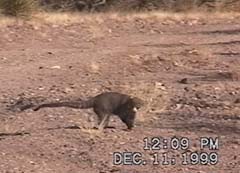
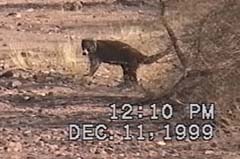
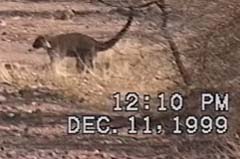
Coati (Nasua narica)
Main sources Nowak, Ronald, 1991, Walker's Mammals of the world, Fifth Edition (two vols.), Baltimore: Johns Hopkins University Press; Hoffmeister, D. F., 1986, Mammals of Arizona, Tucson: University of Arizona Press; Burt, W. & R. Grossenheider, eds., 1976, A Field Guide to the Mammals, Peterson Field Guides: Houghton Mifflin;
Banner photo series above taken in middle Pool Wash on December 11, 1999, using a video camera.
According to Dr. Christine Hass (a mammal ecologist, formerly assistant director at the Audubon Research Ranch located near Elgin, Arizona), "There are 3 known species of coatis; white-nosed coatis (Nasua narica, which exists from the SW US to Panama), South American coatis (Nasua nasua, which live entirely in the forested regions of South America), and the mountain coati (Nasuella olivacea, which lives in the Andes). The status of the Cozumel coati [another variety found only on this island, located off northeastern Yucatan -- RNH] is still under debate, but will likely be listed as a separate species. One biologist in the early 1900's published that all coatis were one species, which he later retracted. Unfortunately, some Mammalogists missed the retraction. Everyone who works on coatis recognizes at least 3 species, and even Wilson & Reeder's "Mammal species of the world", which is the authority for Mammalogists, now recognizes 3 species."
Dr. Hass also told us that the still-current term "coatimundi" should be retired. The term "coati" comes from the Tupi Native American language of Brazil, and "Coatimondi" was first applied in Brazil to solo male coatis ["mondi" means "solitary" in a Brazilian language, RNH], which were originally thought to be a separate species from coatis living in groups. It is probably a good idea to stop using this label, and we do so here.
Coatis may have reached our area of southeastern Arizona only in the twentieth Century, their lands of origin lying well to the south of us. They range in size from 410-670 mm (16"-26") head-&-body length, with tails ranging from 320-690 mm (13"-27") in length (note the proportions in the banner images above), and they weigh from 3-6 kg (8-16 lbs).
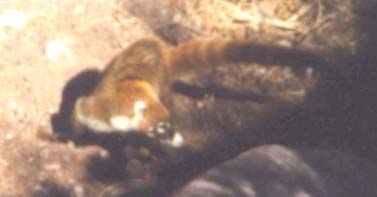 Their furry markings are distinct: a long, ringed tail (but the rings are much less distinctive and spectacular than those of their local cousin, our Ringtail), a whitish nose, chin and throat, behind a black snout and which ends in front of the darkened cheeks, and it also has white spots above and below the eyes. The one we photographed at left (our best effort so far) has a strip of white behind the head, as does the one in the banner image top right, but this is not a species marker (perhaps tribal?). The mask-like character of the face of course links them with their other local procyonid relatives, the Raccoons.
Their furry markings are distinct: a long, ringed tail (but the rings are much less distinctive and spectacular than those of their local cousin, our Ringtail), a whitish nose, chin and throat, behind a black snout and which ends in front of the darkened cheeks, and it also has white spots above and below the eyes. The one we photographed at left (our best effort so far) has a strip of white behind the head, as does the one in the banner image top right, but this is not a species marker (perhaps tribal?). The mask-like character of the face of course links them with their other local procyonid relatives, the Raccoons.
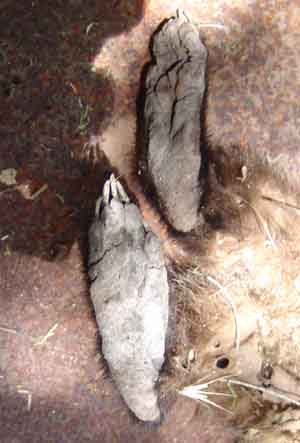
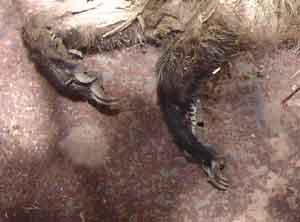 Like raccoons, their front paws are prehensile, while their rear paws are very foot-like.Far left, coati hind-footpads(from a corpse); at near left, the same animal's forepaws. (Note the strong adaptation of the foreclaws for digging after prey.) (click on the images to enlarge them.)
Like raccoons, their front paws are prehensile, while their rear paws are very foot-like.Far left, coati hind-footpads(from a corpse); at near left, the same animal's forepaws. (Note the strong adaptation of the foreclaws for digging after prey.) (click on the images to enlarge them.)
Coatis are diurnal, omnivorous, and excellent climbers, using their tails (semiprehensile, carried erect when walking) as balancing organs. Coatis are highly intelligent animals. For example, see their technique for capturing and eating Tarantulas. Their long, highly mobile snouts are well adapted for exploring crevices. They eat a wide variety of arthropods and some small mammals, but when fruit is abundant they may eat that almost exclusively. We have seen a whole troop feasting noisily in the branches of a Netleaf Hackberry that was full of its small pink fruits. When an inadvertent sound alarmed them, the whole troop marched in order down the tree headfirst and vanished into the nearby bush, from which one or two of them made blustering threat noises.
They run about in matriarchal tribes of a dozen or more (and very much larger tribal groups have been observed occasionally in a few locations). Males become solitary when about two years old, and only during the breeding season, when fruits are ripe and hence there is little competition for food, is a single male accepted into the group. Even at that time, the male is totally subordinate to the females.
In groups Coatis are quite vocally communicative, confident, and courageous. We know Saguaro Juniper people who have stood or sat quietly while large troops of Coatis have approached, milled around the human visitor, casually keeping an eye on the biped in their midst. (Unfortunately, so far none of these folks has happened to carry a camera at the time! We would really have some amazing photos to show on this page, but S-J associates ignore the pleas of frustrated webmasters.)
Below, Coati tracks made in two differing situations. At left and Center, the tracks were made in nearly dry River mud, several months previously. At right, the two tracks (hind paw rear, front paw to right and forward) were made in loose silt, earlier in the same day as the photograph. (click on the images to enlarge them.)
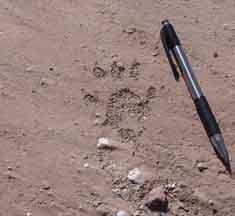 .
.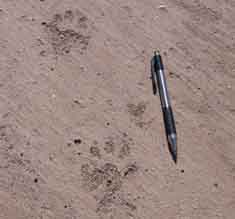 .
.
Below, a Coati skull found alone near the top of Rabbit Ears Saguaro Hill, presumably carried there by a predator. Note the strongly carnivorous character of the teeth, and the rather large cranial size in relation to the rest of the head. These are very intelligent animals indeed.
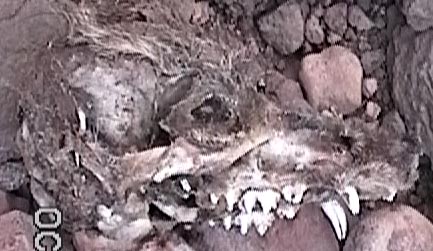
Return to Mammals